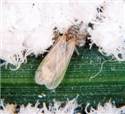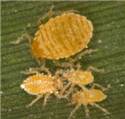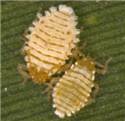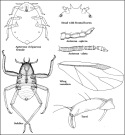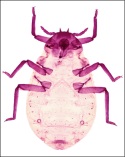Classification
Hormaphidinae: Cerataphidini
Common name(s)
Sugarcane woolly aphid
Diagnosis
Apterae small to medium-sized, pale green or brownish covered with white woolly wax, forming dense colonies on lower sides of leaves of host plant, often attended by ants. Nymphs with little wax dust on body. Wax filaments increase gradually, third instar shows clear intersegmental lines and siphunculi, but fully grown aphid gives totally woolly appearance. Alatae with brown-black head and thorax, and dusky transverse bands on abdominal dorsum. Soldier caste often seen in the colony.
Host plant(s)
Poaceae: Saccharum officinarum L.
Measurements
Aptera: Length of body 2.3, width 1.17; antennae 0.28, segments III: IV:V: 0.06: 0.05: (0.07+0.018); u.r.s. 0.06; h.t.2 0.13.
Alata: Length of body 2.36, width 0.98; antennae 0.68, segments III: IV: V: 0.29: 0.12: (0.15+0.03); u.r.s. 0.06; h.t.2 0.13.
Seasonal occurrence
The pest has spread to all the sugarcane-growing parts of south India. In Karnataka, the pest is found on crops of all the ages almost through the year.
Natural enemies
Coleoptera: Coccinellidae: Anisolemnia dilatata (F.), Curinus coeruleus Mulsant, Cheilomenes sexmaculata (F.), Coelophora biplagiata (Swartz), Harmonia octomaculata (F.), Synonycha grandis (Thunberg).
Hymenoptera: Aphelinidae: Aphelinus desantisi Hayat, Encarsia flavoscutellum Zehntner.




